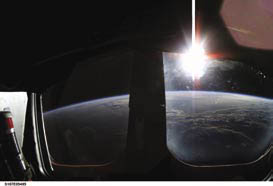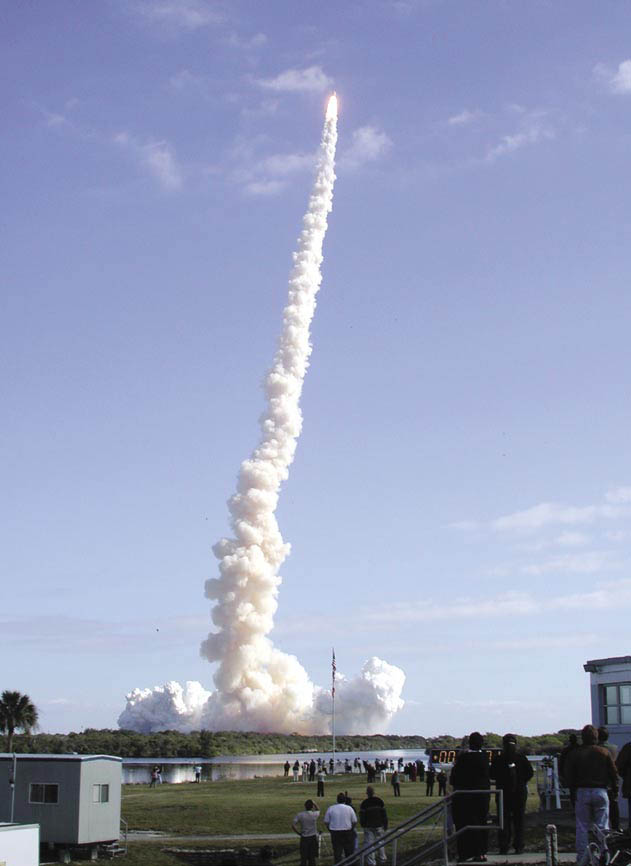Part One The Accident
―第1部 事故―
―第1部 事故―
"Building rockets is hard." Part of the problem is that space travel is in its infancy. Although humans have been launch-ing orbital vehicles for almost 50 years now ュ about half the amount of time we have been flying airplanes ュ contrast the numbers. Since Sputnik, humans have launched just over 4,500 rockets towards orbit (not counting suborbital flights and small sounding rockets). During the first 50 years of aviation, there were over one million aircraft built. Almost all of the rockets were used only once; most of the airplanes were used more often.
「ロケットを作るのはハードな仕事」です。 その問題のひとつは、宇宙旅行がまだ揺籃期にあるということです。人工衛星を打ち上げるようになって約50年、これは飛行機の歴史の約半分にあたる期間ですが、数の上ではずいぶん差があります。スプートニク以来、まだ人類は、4,500機のロケットを衛星軌道に送り込んだにすぎません(ここには、弾道飛行や測量用のロケットは含まれていません)。飛行機は最初の50年で100万機が生産されました。しかも、ほとんどの飛行機が何度も使われるのに対して、ロケットはたった一度しか使われないのです。
There is also the issue of performance. Airplanes slowly built their performance from the tens of miles per hour the Wright Brothers initially managed to the 4,520 mph that Major William J. Knight flew in the X-15A-2 research airplane during 1967. Aircraft designers and pilots would slightly push the envelope, stop and get comfortable with where they were, then push on. Orbital rockets, by contrast, must have all of their performance on the first (and often, only) flight. Physics dictates this - to reach orbit, without falling back to Earth, you have to exceed about 17,500 mph. If you cannot vary performance, then the only thing left to change is the amount of payload - the rocket designers began with small payloads and worked their way up.
また、性能の問題もあります。最初の頃、時速数十マイルでしか飛べなかったライト兄弟から、1967年にX-15A-2実験機で時速4,520マイルを出したウィリアム・J・ナイト少佐まで、航空機はその性能を徐々に上げてきました。航空機の設計者とパイロットたちは少しづつレベルを上げていったのです。彼らは、立ち止まり、自分の立っている場所に満足し、そして再び前に進みました。しかし、衛星軌道を目指すロケットは飛ぶために最低限の能力(そして多くの場合、それが必要充分の能力です)を備えている必要があります。ロケットが地球に落ちることなく衛星軌道に達するためには、時速約17,500マイルを上回らなければなりません。これは、物理学の厳然たる要請です。もし、この性能を出すことができないなら、変えられるものはひとつ。積荷の重さです。ロケットの設計者たちは小さな積荷からはじめて、徐々にそれを大きくしていったのです。
Rockets, by their very nature, are complex and unforgiving vehicles. They must be as light as possible, yet attain out-standing performance to get to orbit. Mankind is, however, getting better at building them. In the early days as often as not the vehicle exploded on or near the launch pad; that seldom happens any longer. It was not that different from early airplanes, which tended to crash about as often as they flew. Aircraft seldom crash these days, but rockets still fail between two-and-five percent of the time. This is true of just about any launch vehicle - Atlas, Delta, Soyuz, Shuttle - regardless of what nation builds it or what basic configura-tion is used; they all fail about the same amount of the time. Building and launching rockets is still a very dangerous business, and will continue to be so for the foreseeable future while we gain experience at it. It is unlikely that launch-ing a space vehicle will ever be as routine an undertaking as commercial air travel - certainly not in the lifetime of any-body who reads this. The scientists and engineers continually work on better ways, but if we want to continue going into outer space, we must continue to accept the risks.
ロケットは、本来的に、複雑でごまかしの許されない乗り物です。衛星軌道に達する非常に優れた能力をもっていながら、限りなく軽く作られていなければなりません。それでも人類はロケットを作るのがずいぶん上手くなりました。最初の頃は発射台の上や、そのそばでよく爆発していたものです。でも、今ではそんなことはめったに起こらなくなりました。これは飛行機も同じですね。飛行機も最初の頃は空を飛ぶのと同じぐらい空から落ちていました。飛行機はもうほとんど落ちることはありませんが、ロケットは今でも2%〜5%の割合で落ちることがあります。これはどんなロケットでも同じです。アトラス、デルタ、ソユーズ、シャトル―どんな国が作った、どんな基本設計を採用したものでも同じです。これらはみな、同じ確率で落ちるのです。ロケットを作り、打ち上げることはいまだにとても危険な仕事です。そして私たちが経験を積もうとしているうちは、それは変わることは無いでしょう。宇宙船を打ち上げることが、飛行機で旅行をすることと同じようなルーチンワークになる日が来るのは、これを読んでいるあなたが生きているうちは難しいかもしれません。科学者と技術者達はより良い方法を探し続けています。それでも、私たちが宇宙へ出て行きたいと思い続けるのなら、私たちはそのリスクを受け入れ続けなければならないのです。
Part One of the report of the Columbia Accident Investiga-tion Board is organized into four chapters. In order to set the background for further discussion, Chapter 1 relates the history of the Space Shuttle Program before the Challenger accident. The events leading to the original approval of the Space Shuttle Program are recounted, as well as an examination of some of the promises made in order to gain that approval. In retrospect, many of these promises could never have been achieved. Chapter 2 documents the final flight of Columbia. As a straightforward record of the event, it con-tains no findings or recommendations. Chapter 3 reviews five analytical paths ュ aerodynamic, thermodynamic, sensor data timeline, debris reconstruction, and imaging evidence ュ to show that all five independently arrive at the same con-clusion. Chapter 4 describes the investigation into other pos-sible physical factors that might have contributed to the accident, but were subsequently dismissed as possible causes.
コロンビア事故調査委員会が作成したこのレポートの第1部は、4つの章からなっています。以後の議論のバックグラウンドとして、第1章はチャレンジャー事故以前のスペースシャトルプログラムの歴史を扱います。スペースシャトルプログラムが最初の承認を得ることになったきっかけと、その承認を得るために必要だった誓約について詳しく説明します。今から思い返すと、これらの誓約はこれまで一度も達成されたことはありませんでした。第2章では、コロンビアの最後の飛行について、起きたことを時間を追って順に述べています。ここには所見も勧告も書かれていません。第3章では、5つの分析方法についてのレビューを行います。空気力学、熱力学、時間順のセンサーのデータ、破片の再構築、そして画像による証拠です。これらの5つの手法は、それぞれ個別に同じ結論を導き出します。第4章では事故を引き起こした可能性のある他の物理的な要因について調査します。しかし、これらは後に事故原因の対象からは外されました。

Sunrise aboard Columbia on Flight Day 7.
打上げから7日目、コロンビアから見た日の出

The launch of STS-107 on January 16, 2003.
2003年1月16日、STS-107の打上げ